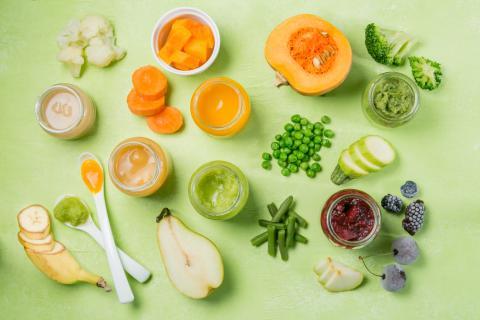
Making a baby transition from milk bottles to his/her first solids can be quite a task. Here are some easy, time-proven ideas…
Babies are nothing if not persistent in refusing any and all coaxing spoons with a firmly closed mouth, head shakes and plenty sputters. Also, baby food jars are often loaded with preservatives and are not-so-great in taste—so here go some interesting and delicious fully homemade organic baby food tips that will hopefully make this change smoother and perhaps a tad lighter on your monthly grocery bills.
Try A Milkshake
Fruit and milk form a very wholesome meal—depending on your baby’s age, you can use expressed breast milk, formula, or cow milk. With respect to fruits, steer clear of the citrus varieties or anything sour as they can curdle the milk. Stick to bananas, peeled and cooked apples or pears, tropical fruits such as mangoes and papayas (8 months onward), and sweet berries. You can use citrus fruits (one year and older) with yogurt instead of milk, making a smoothie rather than a shake. Instead of loading up on flavored yogurt from the store, make your own with strawberries, pineapples, and oranges or limes.
Puree Some Veggies
Your baby isn’t going to immediately love textures. One good way to get those veggies in his little tummy is to boil them till softened and mash them up; you can garnish the same with a baby-safe spice such as powdered cinnamon, turmeric, or cumin to add to the taste. These spices are not hot and adding a pinch here and there adds some health benefits too. Avoid salt till about a year since the kidneys of an infant cannot process salt early on. Once the veggies are done, puree them—you can mix two to three veggies and make a bigger batch—freeze the puree in an ice cube tray and use a cube every time you need to feed the baby. You can thin out the cube as a soup or feed as a puree as per your baby’s liking.
Mix-and-Match
You can do a fruit and veggie puree too—some combinations are avocado and potato, apple and spinach, squash and pear, green beans with apple or pear, sweet potato with pear, and eggplant with applesauce. Depending on the taste of the vegetable and fruit, choose which needs to be rationed more. For example, a teaspoon of pureed spinach mixed with 2-3 tablespoons of applesauce would be a good combination; the opposite may result in sputters, splatters, and firm refusal! You can also choose to cook both fruit and vegetable to avoid any allergies if your baby is younger than 6 months.
Go The Asian Way
South Asia loves its lentils, pulses, or dals. Lentils are actually a great source of protein and dietary fiber and light on little tummies too. Most packets come with cooking instructions; you need to simply boil them in water till they soften and form a paste. Check if they are done by squeezing a lentil between your thumb and forefinger—it should form a smooth paste. You can add water if it’s too thick or let it cook a while longer to thicken it instead as per your baby’s preference and age.
Add Cereals
Cereals are a great way to add some much needed iron in your baby’s diet. Begin with making puddings—rice or semolina pudding in milk sweetened with a fruit puree instead of sugar is usually a treat for babies. You can use powdered rice, gram flour (besan) or fine semolina cooked in cow’s milk. You can also cook the rice in water and add formula later if your little one is still on formula. Another great cereal is barley. To cook powdered barley in water, use 2 tablespoons barley to 1 cup water. Remember to whisk while cooking to avoid any clumping, or simply puree it once to avoid any lumps that your baby may choke on.
Simple and healthy alternatives to the preservative-loaded baby food are possible—and make sure that everything you use or buy off the shelves is organic and certified. If you have any more ideas to share with us, do write in, in the comments section below…








